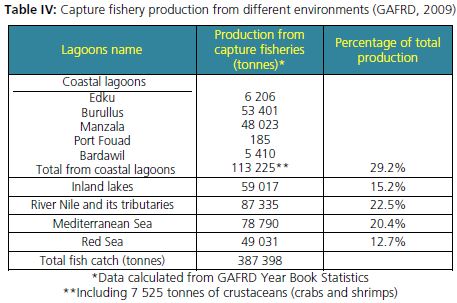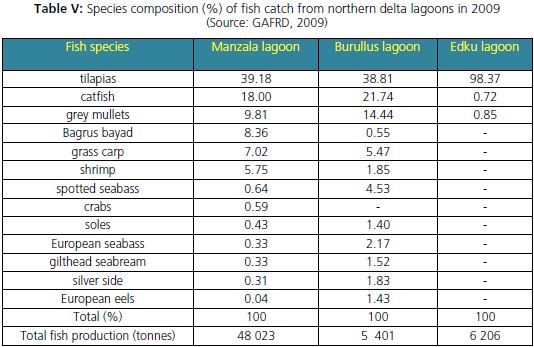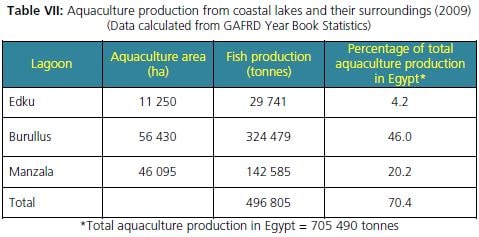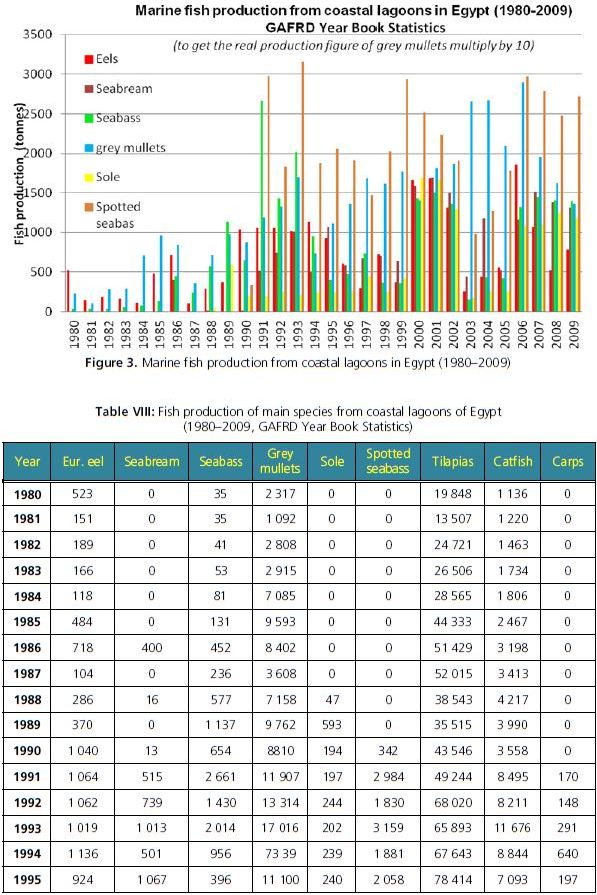3.5 Lagoon exploitation
The main activities carried out in Egyptian coastal lagoons are illustrated in Table III. The most important activities in these lagoons are capture fisheries and aquaculture. The three main delta lagoons (Edku, Burullus and Manzala) yield over 60 percent of Egypt’s annual fish catch. Moreover, aquaculture is the largest single source of fish supply in Egypt, accounting for more than 51 percent of the total fish production of the country. Most aquaculture activities are located along the shores of the north delta lagoons, with hatcheries generally located in the vicinity of the fish farms. The second important activity is agriculture.
After the construction of the Aswan High Dam and the decrease in water volume flow to northern lagoons, large areas around the delta lakes were subjected to drought. These land areas had been reclaimed for agriculture and aquaculture.
Table III: Main activities in Egyptian coastal lagoons

3.5.1 Aquaculture and capture fisheries
Fishing gear
As described by El-Maghraby et al. (1977), the most common fishing gear in coastal delta lagoons are:
Entangling gear
Gillnet: It is is used to catch the Nile perch, Lates niloticus, sometimes grey mullets or tilapias. The length of a gillnet section varies between 10–20 meters.
Trammel net (Nasha and Takem): It is used to catch various fish species including tilapias, grey mullets and others. It consists of three layered walls of webbing.
Stationary trammel net (Saksook): Saksook is a modified type of trammel net used in the Burullus lagoon.
Encircling gear
El-Gafsha: El-Gafsha (Shebak El-Habl): El-Gafsha is the largest of all nets, it is about 500 to 1 000 meters long, 4 meters high, without floats nor weights. Designed to catch grey mullets.
El-Ganeb: Is made up of sections, each of about 15 meters long and 1.5 meters wide attached together.
Trawl gear (dragged gear):
Lokkafa: is a sac-like funnel shaped net, fastened to a wooden frame shaped like a reversed “V”. Lokkafa is not selective.
Kerba : Similar to Lokkafa, but smaller in size, with a modified wooden frame. The wooden frame is triangular in shape
Seine nets: Eshalta: is a common type of seine nets used in lagoons, having 10 m total length. Set nets
Shrimp set net: Consists of two parts, a weir (fence) and a catching box.
Mullet set net: is used mainly at the time of mullet’s migration.
Traps
Wire basket trap
Clarias trap: The whole net consists of three traps joined together and the net is set between two banks of a freshwater stream; traversing the water flow.
Hook and line gear
Cast nets (Torraha or Shabka)
Hosha: It is an enclosure located mostly at the southern shores of the lake, as well as around some islands. It is a pond having shallow water basin built by erecting low dykes made of mud and straws. It has one or more narrow openings connecting it with the lake: Hosha are periodically closed, water is pumped out and the fish are harvested.
In addition, fishing is performed by simple methods such as catch by hand or catching fish concealed under aquatic weeds using surrounding nets.
Work force, establishments and institutions
The number of cooperative societies in Egypt was recorded to be 93 in 2007 (Barrania, 2007). The largest and the most active society is the “Co-operative union of aquatic resources” in addition to other 82 local societies and ten aquaculture societies. The activities of these societies are not limited to coastal lagoons, but they extend to all other fishery and aquaculture activities in the country. It is very difficult to estimate the actual number of fishers in the coastal lagoons of Egypt, because the number of unlicensed workers may exceed those licensed. In the Bardawil lagoon, the number of licensed fishers in 2009 was 3 460, engaged in five cooperatives. The number of licensed boats in the lagoon was 1 159, mostly motorized. In Burullus, 30 000 fishers are working in the lagoon but only 10 300 of them are licensed. Licensed boats in the lake in 2003 reached 10 000 (GAFRD, 2009), only 160 of these are motor boats and the rest are “sambouk” (small rowing boat), “felouka” (medium size rowing boat) and sailing boats (large boats). In the Manzala lagoon, the number of fishers working in the lagoon is estimated at 22 000, but only 13 000 are licensed (GAFRD, 2009). The number of licensed boats is recorded as 6 781 in 2009. In the Edku lagoon, the number of licensed fishers is recorded as 6 000 working on 3 000 licensed boats, mostly non-motorized.
Aquaculture and capture fishery management
From 2004 to 2007 there was a stock enhancement programme to supply Burullus and Edku lagoons with fish seed from governmental hatcheries. During these years 3 million grass carp and 8 million Nile tilapia fry were released in the Burullus lagoon and about 4 million Nile tilapia fry were released in the Edku lagoon (GAFRD, 2009). There iso available data on the stocking programme’s progress. Regarding aquaculture, it is estimated that about 100 000 ha of reclaimed land were converted to aquaculture ponds in the last 30 years. Most of these aquaculture facilities are located at the southern parts of coastal lagoons to receive drainage freshwater.
Fish production
Fish production from northern lagoons varies over time, even though it significantly contributes to national fish production. Total fish production in Egypt amounted to more than one million tonnes in 2009, of which 387 398 tonnes (35.4 percent) from capture fisheries. Thirty percent of the total capture fish production comes from Northern lagoons (113 225 tonnes) (Table IV). Fish and crustacean production of main species are illustrated in Figures 3 and 4 and Table V.
Table IV: Capture fishery production from different environments (GAFRD, 2009)

*Data calculated from GAFRD Year Book Statistics
**Including 7 525 tonnes of crustaceans (crabs and shrimps)
Species composition of the catch of northern delta lagoons showed relatively high diversity in the Manzala and Burullus lagoons but very low diversity in the Edku lagoon (Table V). This phenomenon needs more investigations as these lagoons have almost the same water characteristics.
Table V: Species composition (%) of fish catch from northern delta lagoons in 2009
(Source: GAFRD, 2009)

In the Bardawil lagoon, the total fish catch increased from 2 227 tonnes in 2004 to 5 410 tonnes in 2009. However, there was a drastic decrease in catch of highly valued fish (gilthead seabream and flathead grey mullet) and an increase in low value small shrimp and
78
crabs (Table VI). The phenomenon was studied by Abdel Razek et al. (2008) and concluded that it is due to illegal fishing methods.
Table VI: Fish catch and percentage species composition from Bardawil lagoon (2004 and 2009) (Source: GAFRD Year Book Statistics)

Aquaculture production amounted to about 705 490 tonnes in 2009, representing about 64.6 percent of total fish production in Egypt. The aquaculture production sector is clustered around the shores of coastal lagoons benefitting from the reclaimed cheap land and water availability from drains. The contribution to fish production of aquaculture around the northern lakes is very great. In 2009, fish production from aquaculture activities in the coastal lakes and their surroundings amounted to about 496 805 tonnes, representing ~70.4 percent of total aquaculture production in the country (Table VII). The share of aquaculture in Egyptian fish production increased from 17 percent in 1991 to 65 percent in 2009 (Fig. 5).
Table VII: Aquaculture production from coastal lakes and their surroundings (2009)
(Data calculated from GAFRD Year Book Statistics)

*Total aquaculture production in Egypt = 705 490 tonnes
Figure 3. Marine fish production from coastal lagoons in Egypt (1980–2009)
Table VIII: Fish production of main species from coastal lagoons of Egypt
(1980–2009, GAFRD Year Book Statistics)


Figure 4. Crustacean production from coastal lagoons of Egypt (1986–2009), GAFRD Year Book Statistics)
Table IX: Crustacean production from coastal lagoons of Egypt
(1986–2009, GAFRD, Year Book Statistics)

Figure 5. Fish production in Egypt by sector in 1991 and 2009
Source: GAFRD Year Book Statistics (1991–2009)
In conclusion, fish production (capture and culture) from northern coastal lakes added up to about 610 030 tonnes in 2009, representing about 55.8 percent of total Egyptian fish production. Regarding cultured fish species in all Egypt (including North lagoons), tilapias showed the highest production (~360 000 tonnes) in 2009 ranking second in world tilapia production, and grey mullets production reached 209 421 tonnes (30 percent) ranking first in the world (Table X). Cultured mullet species in Egypt include mainly the thinlip grey mullet (Liza ramada), flathead grey mullet (Mugil cephalus) and bluespot mullet (Valamugil seheli). Data on aquaculture production of each species of grey mullets is not available, but fry species composition data showed that the collected seeds in 2005 are composed of 80 percent Liza ramada, 11.5 percent Mugil cephalus and 9 percent Valamugil seheli (Saleh, 2008). Cultured tilapia species include mainly Oreochromis niloticus with other minor species as Oreochromis aureus, Sarotherodon galilaeus and Tilapia zillii (El-Sayed, 2006).
Table X: Egyptian aquaculture production according to species

(Source: GAFRD Year Book Statistics)
Species Production (tonnes) %
Tilapias 359.76 51
Grey mullets 209.42 30
others* 136.31 19
Total 705.49
*mainly carps
3.5.2 Other uses
Recreational activities
In the Burullus, Manzala and Edku lagoons, tourism activities are mainly concentrated in the north along the Mediterranean coast, on the sand bars of these lagoons. It is visited by Egyptian tourists coming from Cairo and Nile delta cities in summer months. There are three famous towns in these lagoons (Maadia, Baltim and Gamasa).
In the Bardawil lagoon, tourism resorts are spreading west of Arish town up to the borders of the Zaranik protected area. The Mediterranean coast in this area has a good climate all throughout the year with many palm-fringed beaches. This tourist potential attracts both Egyptian and Arab tourists. In addition, there are a number of archeological sites near the lagoon dating to Roman and Islamic periods. Bird watchers and ornithologists visit the lagoon occasionally in very few numbers. However, there are only few visitors to the area due to the lack of facilities and restricted access to the shore, sandbar and the lagoon placed by military authorities.
Others
Other activities in the coastal lagoons of Egypt include: 1) bird hunting; in delta lakes, where most people who work in fisheries also practice bird hunting. The main markets for these wild birds are Alexandria, Damietta and Rosetta. This activity may pose threats to the lakes’ value as a wetland area and breeding area for a lot of water bird species, 2) grazing of sheep and cattle, 3) salt production, 4) reed harvesting and 5) some other small industries (fish salting, Batarekh production, shipyards, etc.).